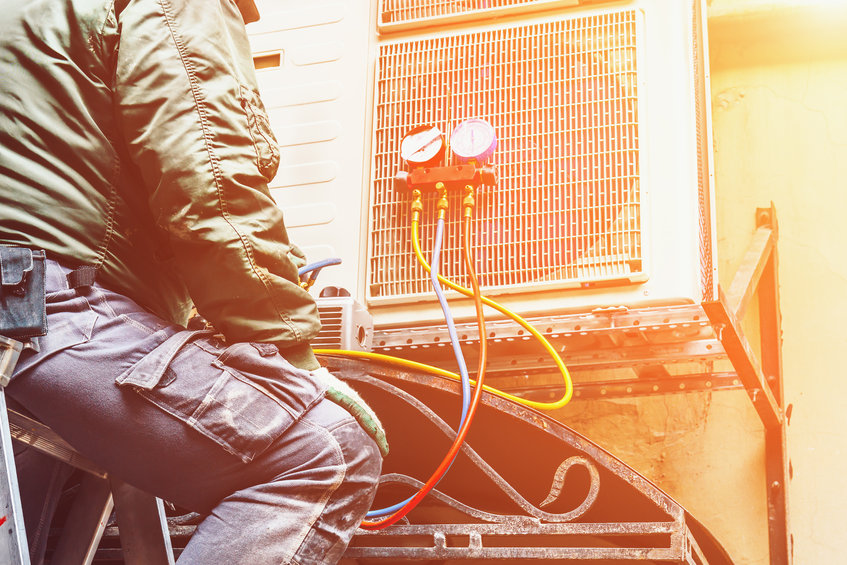An air conditioning unit requires regular maintenance to ensure it is operating effectively and efficiently. Not only will this reduce strain on the unit’s system but also prolongs its life and prevents costly replacements or repairs. Since this unit works harder to keep you cool in summer and warm during winter, it is important to keep up with maintenance to avoid any inconveniences when everyone needs it the most. Familiarizing yourself with your AC system can help you identify problems before they happen. This article discusses a list of maintenance items to conduct on an AC system to keep it in good working condition all year round.
- Clean the Outdoor Condenser Unit
Before you turn on your cooling system for summer, check out the outdoor unit as it accumulates debris over time, just like your gutters.

Make sure to get rid of any debris, leaves, or twigs gathered around it. Besides getting rid of the debris, consider cleaning your outdoor condenser unit thoroughly with a garden hose. It is important to turn off the power source of your air conditioner before you start working on the unit. After washing the remaining dirt with your garden hose, inspect the outdoor condenser unit fins for damage.
- Air Filter Replacement
Checking your AC’s air filter every month and cleaning or replacing it after a 30- to 90-day period can help prolong its lifespan and allow it to operate at peak performance. One of the practical ways to check whether the air filter needs a replacement is to hold it up to the light to check if the light is passing through. If you cannot see any light then it means the filter is clogged and needs to be replaced or cleaned immediately. A dirty air filter prevents your HVAC from working properly due to limited airflow.
- Inspect Insulation Levels
Chances are that you improved your home’s insulation by winterizing your home. If you have not done it yet then you can always make a few changes with energy-efficient upgrades. The best way to inspect insulation levels is to check in the attic with a measuring stick if it is above or below 10 inches. Anything less than 11 inches of rock wool or fiberglass installation, or less than 8 inches of cellulose will require extra insulation. Consider a spray form when replacing your attic insulation as it has higher R-value insulation.
- Find and Seal Air Leaks
Test the areas you suspect leaks using a burning incense stick or a piece of thin toilet paper. You will know that there is air movement around the area if the paper or smoke begins to move erratically. Weatherproof caulk may come in handy when sealing air leaks in your home. It works best for leaks smaller than ¼ inch. Any gaps larger than ¼ inch will require something more efficient like an expandable foam spray. Sealing off air leaks prevents your air conditioner from working harder than it should.
- Upgrade Your Thermostat
It is important to learn how to use your thermostat or at least consider upgrading to one if you do not have it. Different types of thermostats operate differently based on your selected or preferred schedule. Once you have purchased or upgraded your thermostat, it does not stop there. You need to program it strategically if you want to get the benefits of its maximum potential. You can program it to 26 degrees Celsius or 78 degrees Fahrenheit when you are at home and 10 percent higher when you are away. Any degree set above this mark can help save about one percent of your cooling costs.
- Tune Up Your AC
You can accomplish more than you could ever imagine with a professional air conditioning tune-up. This includes checking the refrigerant level, tightening electrical connections, clearing the drain line for condensation, and lubricating moving parts. Spring is one of the best seasons to schedule an air conditioning tune-up. It helps improve comfort and indoor air quality, lower energy bills, and reduce breakdowns. An AC tune-up may also include a full thermostat calibration to verify it is operating properly. Your contractor will evaluate the condition of the blower belt and the performance of the blower motor.
A professional tune-up of your air conditioner may cover some of the above air conditioning maintenance tips. It is always important to check with your contractor whether filter replacements, condenser unit cleaning, and A/C condensate cleaning are included in the tune-up. Taking proper care of your air conditioning system not only prolongs its lifespan but also brings comfort to your home all year round.
